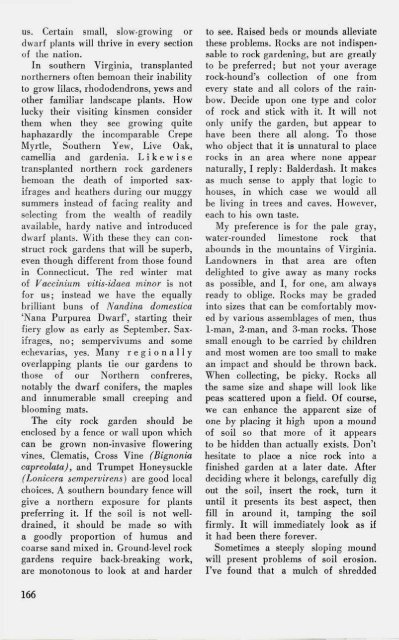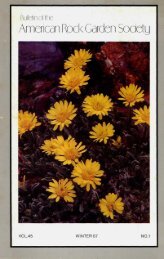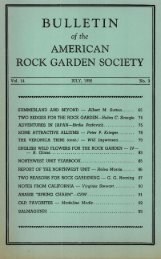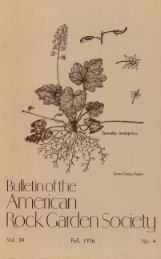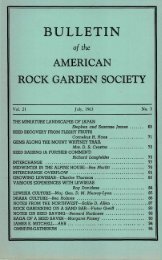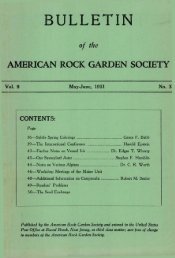Bulletin - Fall 1979 - North American Rock Garden Society
Bulletin - Fall 1979 - North American Rock Garden Society
Bulletin - Fall 1979 - North American Rock Garden Society
Create successful ePaper yourself
Turn your PDF publications into a flip-book with our unique Google optimized e-Paper software.
us. Certain small, slow-growing ordwarf plants will thrive in every sectionof the nation.In southern Virginia, transplantednortherners often bemoan their inabilityto grow lilacs, rhododendrons, yews andother familiar landscape plants. Howlucky their visiting kinsmen considerthem when they see growing quitehaphazardly the incomparable CrepeMyrtle, Southern Yew, Live Oak,camellia and gardenia. Likewisetransplanted northern rock gardenersbemoan the death of imported saxifragesand heathers during our muggysummers instead of facing reality andselecting from the wealth of readilyavailable, hardy native and introduceddwarf plants. With these they can constructrock gardens that will be superb,even though different from those foundin Connecticut. The red winter matof Vaccinium vitis-idaea minor is notfor us; instead we have the equallybrilliant buns of Nandina domestica'Nana Purpurea Dwarf, starting theirfiery glow as early as September. Saxifrages,no; sempervivums and someechevarias, yes. Many regionallyoverlapping plants tie our gardens tothose of our <strong>North</strong>ern confreres,notably the dwarf conifers, the maplesand innumerable small creeping andblooming mats.The city rock garden should beenclosed by a fence or wall upon whichcan be grown non-invasive floweringvines. Clematis, Cross Vine (Bignoniacapreolata), and Trumpet Honeysuckle(Lonicera sempervirens) are good localchoices. A southern boundary fence willgive a northern exposure for plantspreferring it. If the soil is not welldrained,it should be made so witha goodly proportion of humus andcoarse sand mixed in. Ground-level rockgardens require back-breaking work,are monotonous to look at and harderto see. Raised beds or mounds alleviatethese problems. <strong>Rock</strong>s are not indispensableto rock gardening, but are greatlyto be preferred; but not your averagerock-hound's collection of one fromevery state and all colors of the rainbow.Decide upon one type and colorof rock and stick with it. It will notonly unify the garden, but appear tohave been there all along. To thosewho object that it is unnatural to placerocks in an area where none appearnaturally, I reply: Balderdash. It makesas much sense to apply that logic tohouses, in which case we would allbe living in trees and caves. However,each to his own taste.My preference is for the pale gray,water-rounded limestone rock thatabounds in the mountains of Virginia.Landowners in that area are oftendelighted to give away as many rocksas possible, and I, for one, am alwaysready to oblige. <strong>Rock</strong>s may be gradedinto sizes that can be comfortably movedby various assemblages of men, thus1-man, 2-man, and 3-man rocks. Thosesmall enough to be carried by childrenand most women are too small to makean impact and should be thrown back.When collecting, be picky. <strong>Rock</strong>s allthe same size and shape will look likepeas scattered upon a field. Of course,we can enhance the apparent size ofone by placing it high upon a moundof soil so that more of it appearsto be hidden than actually exists. Don'thesitate to place a nice rock into afinished garden at a later date. Afterdeciding where it belongs, carefully digout the soil, insert the rock, turn ituntil it presents its best aspect, thenfill in around it, tamping the soilfirmly. It will immediately look as ifit had been there forever.Sometimes a steeply sloping moundwill present problems of soil erosion.I've found that a mulch of shredded166


